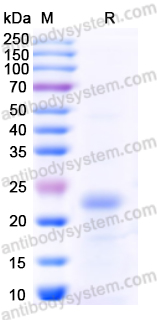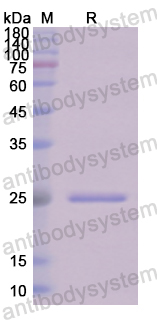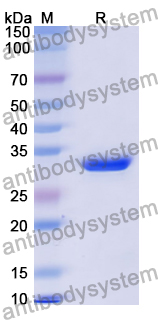Catalog No.
YHB99001
Expression system
E. coli
Species
Homo sapiens (Human)
Protein length
Ser21-Ala99
Predicted molecular weight
21.30 kDa
Nature
Recombinant
Endotoxin level
Please contact with the lab for this information.
Purity
>90% as determined by SDS-PAGE.
Accession
P02656
Applications
ELISA, Immunogen, SDS-PAGE, WB, Bioactivity testing in progress
Form
Lyophilized
Storage buffer
Lyophilized from a solution in PBS pH 7.4, 1mM EDTA, 4% Trehalose, 1% Mannitol.
Reconstitution
Reconstitute in sterile water for a stock solution. A copy of datasheet will be provided with the products, please refer to it for details.
Shipping
In general, proteins are provided as lyophilized powder/frozen liquid. They are shipped out with dry ice/blue ice unless customers require otherwise.
Stability and Storage
Use a manual defrost freezer and avoid repeated freeze thaw cycles. Store at 2 to 8°C for frequent use. Store at -20 to -80°C for twelve months from the date of receipt.
Alternative Names
APOC3, Apolipoprotein C3, Apo-CIII, Apolipoprotein C-III, ApoC-III
Proteogenomic and observational evidence implicate ANGPTL4 as a potential therapeutic target for colorectal cancer prevention., PMID:40511612
Robust Serum Proteomic Signatures of APOE2., PMID:40501769
Treatment with orforglipron, an oral glucagon like peptide-1 receptor agonist, is associated with improvements of CV risk biomarkers in participants with type 2 diabetes or obesity without diabetes., PMID:40481478
Integrating network pharmacology, quantitative transcriptomic analysis, and experimental validation revealed the mechanism of cordycepin in the treatment of obesity., PMID:40438591
Cholesteryl Ester Transfer Protein Deficiency and Hyperalphalipoproteinemia., PMID:40436797
Prediction of Interspecies Translation for Targeting Delivery Coefficients of GalNAc-siRNA Silencing Apolipoprotein C-III Using a Mechanistic Minimal Physiologically Based Pharmacokinetic/Pharmacodynamic Model., PMID:40317426
Potential of CETP inhibition in treating dyslipidemia in systemic lupus erythematosus: Novel and comprehensive evidence from clinical studies and Mendelian randomization., PMID:40315629
Cholesterol metabolism-related genes predict immune infiltration and prognosis in gastric cancer patients., PMID:40302802
Discovery of Novel APOC3 Isoforms in Hepatic and Intestinal Cell Models Using Long-Read RNA Sequencing., PMID:40282372
Genetics of remnant cholesterol., PMID:40277396
Pancreatic β-cell apoptosis caused by apolipoprotein C3-rich low-density lipoprotein is attenuated by kansuinine A through oxidative stress inhibition., PMID:40262236
Novel Therapeutics for Familial Chylomicronemia Syndrome., PMID:40257687
Increased serum APOC3 in patients with syphilis can predict the absence of Jarisch-Herxheimer reaction after benzathine penicillin treatment., PMID:40241422
Loss-of-Function in APOC3 and Protection Against Aortic Valve Disease., PMID:40240096
Olezarsen for the Treatment of Familial Chylomicronemia Syndrome., PMID:40231656
G3BP1, a stress granule core protein, ameliorates metabolic dysfunction-associated fatty liver disease by attenuating hepatocyte lipid deposition., PMID:40230220
Genetically determined increase in apolipoprotein C-III (APOC3 gain-of-function) delays very low-density lipoprotein clearance in humans., PMID:40203662
Associations Between APOC3 and ANGPTL8 Gene Polymorphisms With MASLD Risk and the Mediation Effect of Triglyceride on MASLD in the Chinese Population., PMID:40192643
Safety and efficacy of antisense oligonucleotides on triglyceride, apolipoprotein C-III, and other lipid parameters levels in hypertriglyceridemia; a network meta-analysis of randomized controlled trials., PMID:40119340
Joint Associations of APOC3 and LDL-C-Lowering Variants With the Risk of Coronary Heart Disease., PMID:40105833
Effect of Targeting ApoC-III With Plozasiran on Lipoprotein Particle Size and Number in Hypertriglyceridemia., PMID:40099777
Familial chylomicronemia syndrome and treatments to target hepatic APOC3 mRNA., PMID:40068508
Increased circulating apolipoprotein Cs are implicated in the association between elevated serum retinol and retinol-binding protein 4 and adverse progression of metabolic syndrome in adults: A prospective study., PMID:40054673
Evaluating the Cardiometabolic Efficacy and Safety of Lipoprotein Lipase Pathway Targets in Combination With Approved Lipid-Lowering Targets: A Drug Target Mendelian Randomization Study., PMID:40052268
Gallic acid alleviates ferroptosis by negatively regulating APOC3 and improves nerve function deficit caused by traumatic brain injury., PMID:40050387
Development of iPSC-derived FIX-secreting hepatocyte sheet as a novel treatment tool for hemophilia B treatment., PMID:39988667
APOC3 as a potential prognostic factor for hepatitis B virus-related acute-on-chronic liver failure., PMID:39928771
Apolipoprotein C3 and risk of cardiovascular events and death in patients on optimized statin treatment after recent acute coronary syndrome., PMID:39921475
Cascade screening of a Pakistani consanguineous familial hypercholesterolemia cohort: Identification of seven new homozygous patients., PMID:39903948
The association of lipids and novel non-statin lipid-lowering drug target with osteoporosis: evidence from genetic correlations and Mendelian randomization., PMID:39893413
Genetic association analysis of lipid-lowering drug target genes in chronic kidney disease., PMID:39877840
Molecular Therapeutics in Development to Treat Hyperlipoproteinemia., PMID:39875700
Apolipoprotein CIII correlates with lipoproteins in the fed state and is not regulated by leptin administration in states of hypoleptinemia induced by acute or chronic energy deficiency: Results from two randomised controlled trials., PMID:39810632
Exploring emerging pharmacotherapies for type 2 diabetes patients with hypertriglyceridemia., PMID:39794291
Triglyceride-independent associations between circulating levels of apolipoprotein C-III and biomarkers of inflammation., PMID:39780204
Cutting-edge lipid-lowering pharmacological therapies: Improving lipid control beyond statins., PMID:39765369
Arsenic Exposure Triggers Nonalcoholic Fatty Liver Disease through Repressing S-Adenosylmethionine-Dependent Histone Methylation in Rats., PMID:39746780
Genetic correlation between genes targeted by lipid-lowering drugs and venous thromboembolism: A drug-target Mendelian randomization study., PMID:39705479
Multifaceted Role of Apolipoprotein C3 in Cardiovascular Disease Risk and Metabolic Disorder in Diabetes., PMID:39684468
Familial chylomicronemia: New perspectives., PMID:39672668
An up-to-date review of emerging biologic therapies for hypercholesterolemia., PMID:39668448
Protective effects of betaine on the early fatty liver in laying hens through ameliorating lipid metabolism and oxidative stress., PMID:39654538
New drugs for treating dyslipidemias. From small molecules to small interfering RNAs., PMID:39645293
ApoC-III proteoforms are associated with better lipid, inflammatory, and glucose profiles independent of total apoC-III., PMID:39633383
Lipid-lowering therapies for aortic stenosis: a drug-target Mendelian randomization study., PMID:39611306
Insights into Medication-Induced Osteonecrosis of the Jaw Through the Application of Salivary Proteomics and Bioinformatics., PMID:39596473
Heavy metal exposure and its effects on APOC3, CFAI, and ZA2G., PMID:39579699
Curcumin inhibits the progression of hyperlipidemia via OGT mediated O-GlcNAcylation modulation of APOC3., PMID:39579540
Targeted multiplex proteomics for the development and validation of biomarkers in primary aldosteronism subtyping., PMID:39556467
Proteomic study of cerebrospinal fluid in adult tethered cord syndrome: Chemical structure and function of apolipoprotein B., PMID:39547612



